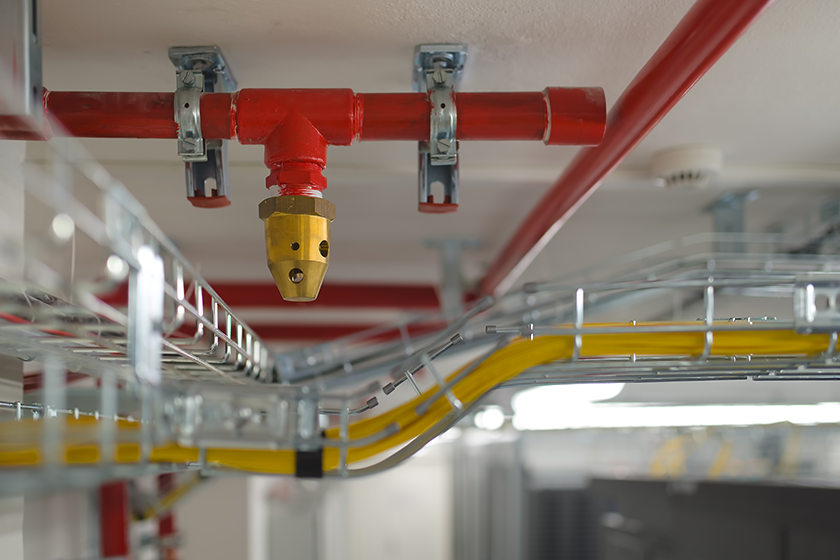8 Fire Detection System Types: From Basic To Advanced Solutions

Fire detection is a pivotal part of any safety system. Understanding the different fire detection system types can help you choose the best one for your property.
From basic smoke detectors to advanced multi-sensor systems, each has its own set of benefits and applications. In this article, we will take a closer look at various fire detection systems, explaining how they work and where they should be used.
Fire Detection System Types
- Heat Detectors
Heat detectors are straightforward devices that activate when they sense a significant increase in temperature. These systems do not respond to smoke. This makes them ideal for areas where smoke might be present but a fire is unlikely, such as storage rooms, warehouses, or kitchens.
The detectors measure the temperature and compare it to preset thresholds. When the temperature surpasses the threshold, the alarm triggers.
There are two main types of heat detectors: fixed temperature and rate-of-rise. Fixed temperature detectors activate when the temperature exceeds a certain preset level, typically between 135°F and 190°F.
On the other hand, rate-of-rise detectors respond when the temperature increases at a certain rate, regardless of the absolute temperature. These are particularly useful in spaces where rapid temperature changes could signal an emerging fire.
However, heat detectors are not always the best choice for buildings with a high risk of smoke or toxic gases. Their slow response time is another limitation compared to smoke detectors. Despite these drawbacks, they are reliable in areas where other detection methods could result in frequent false alarms, such as boiler rooms or areas with heavy machinery.
For more advanced options, look into our comprehensive range of fire alarm services that can help you identify the right system for your needs.
- Ionization Smoke Detectors
Ionization smoke detectors use a small amount of radioactive material to ionize the air inside the detector. This creates a current of electricity that flows between two plates.
When smoke enters the detector, it disrupts the ionization, and the electrical current decreases, triggering the alarm. These detectors are particularly sensitive to small smoke particles. This makes them effective in detecting fast-flaming fires, often seen in combustible materials like paper or fabric.
These devices are widely used in commercial kitchens and restaurants due to their quick response time to small, fast-moving fires. However, ionization smoke detectors have certain drawbacks. High humidity, dust, or steam can cause false alarms.
They are also becoming less popular due to their use of radioactive materials–which have led to environmental and safety concerns. As a result, many buildings are switching to more eco-friendly technologies.
An ionisation detector can be a good choice for locations where fast-responding fire detection is needed. Their efficiency in detecting small, fast-moving fires makes them a preferred option in specific applications.
- Photoelectric Smoke Detectors
Photoelectric smoke detectors are another common type of smoke detection device. These detectors use a light source, usually an LED, and a photodetector. When smoke enters the chamber, it scatters the light, which is then detected by the photodetector. This triggers the alarm.
Unlike ionization detectors, photoelectric systems are more responsive to smoldering fires that produce large particles of smoke. These fires often occur in areas where materials like foam, plastic, and upholstery are involved.
The main advantage of photoelectric smoke detectors is their sensitivity to visible smoke, especially smoldering fires that burn slowly before fully igniting. For this reason, they are ideal for use in bedrooms, living rooms, or hallways—places where fires might start slowly and remain unnoticed without early detection.
However, photoelectric detectors are not as effective at detecting fast-flaming fires. This is why some fire safety systems use a combination of ionization and photoelectric technologies.
Photoelectric detectors are easy to maintain and often less prone to false alarms than ionization detectors. Due to their reliability, they are increasingly used in residential settings, schools, and office buildings. With advancements in technology, newer models have become highly accurate and less prone to false alarms. They are a popular choice for residential and commercial spaces.
- Combination Smoke Detectors
Combination smoke detectors integrate both ionization and photoelectric technologies into one unit. By doing this, they combine the benefits of both types of detection. This provides more comprehensive protection.
These detectors use a combination of a light sensor and an ionization chamber. Therefore, they can detect both fast-flaming and smoldering fires. The main advantage of a combination smoke detector is that it offers a more well-rounded detection capability. It’s suitable for a wide range of environments.
While these detectors provide a more complete solution for fire detection, they are not without their drawbacks. For one, they tend to be more expensive than single-technology detectors. Nevertheless, their ability to detect a wider range of fires often makes them a better investment in the long term. They can be especially useful in buildings with varying fire risks across different areas.
The popularity of combination smoke detectors has increased significantly in recent years. They are commonly used in both residential and commercial buildings to offer a higher level of fire safety. As fire safety solutions evolve, combination detectors present a convenient option for those who want to make sure their property is protected from various fire risks.
- Flame Detectors
Flame detectors are highly specialized devices that detect the infrared or ultraviolet radiation emitted by flames. These detectors are used in environments where fires are likely to start quickly and can escalate in a short period.
Industries such as oil and gas, chemical plants, and power stations often rely on flame detectors due to the high risk of explosive fires. These detectors can distinguish between different types of radiation and can be tuned to detect specific wavelengths corresponding to fire.
Infrared flame detectors are commonly used for areas where flames emit a strong infrared radiation signature, such as in furnace rooms or industrial processing plants. They work by sensing the heat emitted by a fire and activating the alarm when a significant temperature is detected. On the other hand, ultraviolet flame detectors work by detecting the UV light emitted by flames.
While flame detectors are highly effective in detecting open flames, they are typically used in more specialized industrial settings rather than general buildings. Their ability to detect fire at an early stage makes them valuable in high-risk environments, where rapid detection is paramount to preventing large-scale fires.
- Gas Detectors
Gas detectors play a huge role in fire safety, particularly when gases or flammable liquids are present. These detectors are designed to detect the presence of combustible gases, such as methane, carbon monoxide, and propane, before they reach dangerous concentrations. When a gas leak occurs, the detector will activate an alarm to warn of potential fire hazards.
Unlike smoke detectors, which are activated by fire, gas detectors focus on detecting hazardous gases in the air. In commercial kitchens, gas detectors monitor for leaks from stoves, ovens, or other cooking equipment. In industrial settings, these detectors can help prevent fires or explosions caused by volatile gases.
Because gas detectors are highly specialized, they are not used as standalone fire detection systems. Instead, they are typically integrated with other fire safety systems, such as smoke detectors or fire alarm panels. In spaces where flammable gases are used or stored, having a gas detector in place can significantly reduce the risk of an accidental fire or explosion.
- Linear Heat Detectors
Linear heat detectors (LHDs) are designed to detect temperature changes along a predetermined length of cable. These detectors are often used to protect large areas or long stretches of piping where traditional point detectors might not be effective. The cable, which is typically installed along the ceiling or walls, is designed to detect temperature changes. If the temperature rises above a set threshold, the system will trigger an alarm.
Linear heat detectors are often used in environments where there is a need to detect temperature changes over long distances. They are frequently used in places like warehouses, parking garages, or tunnels where temperature variations can indicate a developing fire.
Different from traditional point detectors, which can only detect heat at a specific location, linear heat detectors can monitor a wide area simultaneously. They offer more comprehensive coverage.
One limitation of linear heat detectors is that they do not bring the same level of precision as other types of temperature detectors. They may not always identify the exact source of heat within a large area. However, their ability to cover vast spaces with a single system makes them an attractive solution for many large-scale facilities.
- Aspirating Smoke Detection Systems
Aspirating smoke detection systems are among the most advanced fire detection systems available. These systems work by drawing air through a network of pipes to a central detection unit, where the air is analyzed for smoke. Because they continuously monitor air quality, aspirating smoke detectors are highly sensitive and can detect the earliest signs of smoke long before other systems can.
Aspirating systems are often used in areas that require extremely fast and accurate detection. Their ability to monitor air quality in real-time allows them to detect smoke at levels too low for traditional detectors to pick up. These systems are particularly effective in sensitive environments where a fire, even a small one, can cause significant damage.
While aspirating smoke detectors offer superior sensitivity, they are also more expensive and require regular maintenance to assure optimal performance. Due to the complexity of the system, they are typically used in high-value or mission-critical environments.
Protecting Your Property With the Right Fire Detection System
Fire Safety Alarms knows that every property has unique fire safety needs. Our expertise in fire alarm services and emergency management means we can help you select the right fire detection system for your building.
We prioritize your safety and work hard to deliver reliable, efficient solutions tailored to your property’s needs.
